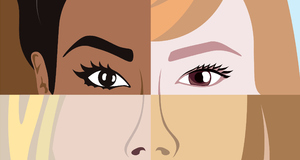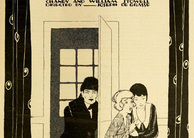Featured Article:Intersections of Gender, Race and Nation in Cloud Nine and M. Butterfly
By
2016, Vol. 8 No. 10 | pg. 2/2 | « In this way, Gallimard talks himself into a masculine identity in opposition to Song’s passive femininity. In particular, she reinforces his masculinity on the subject of his sexual infertility. He confides to her that on account of experiencing difficulty in conceiving, his wife Helga has been to see a doctor who has pronounced her perfectly healthy. Thus she asks him to go see the doctor also. Gallimard is immensely threatened by this because all the signs are that he is infertile, and patriarchy naturalises the link between the male body and masculinity: Song dismisses the modern Western desire for equality as “odd” and makes Gallimard promise not to go to the doctor, laying the blame squarely on Helga: Who is this Western doctor to set himself up as judge over the man I love? I know who is a man and who is not.” (41) That is, what Song knows is that in terms of how society defines a man, Gallimard does not quite measure up and thus, she sets about procuring a baby boy through China’s illegal baby trade. Thus, by all appearances, unlike Helga, Song falls pregnant easily. Here Hwang illustrates Butler’s idea that sex, as well as gender, is culturally constructed because the male-bodied Song has a baby, whilst the female-bodied Helga does not. Much is made of the baby’s typically Western features – his blue eyes, his lips and blonde hair. Song emphasises that he takes after Gallimard and yet for all that, she announces: “I’m going to call him Peepee.” (51) Gallimard protests but Song’s word is final: “His name is as I registered it. And he will never live in the West.” (52) Identity is constructed though language and this name confers a Chinese identity on the baby. It illustrates that there is no natural link between the signifier and the signified; the name Peepee and the nationality it implies are at odds with the baby’s otherwise Western masculine identity. Furthermore, “Peepee” suggests a “detachable phallus” (Garber 139), emphasizing that the sexual body and gendered identity (it is emphasized that the baby is a boy) are not natural but (literally in this case) constructed in language and culture. However, race and nation, though culturally constructed, permit the existence of a cultural difference. (Garber 139) Thus in spite of its appearance, by virtue of its name, this baby is more Asian than Caucasian, more Chinese than French. Whilst the figure of the baby disrupts the relationship between femininity and “Orientalism,” it is but a singular example in the wider context of a culture which upholds and perpetuates the binary oppositions on which it is founded through institutions such as the law. Indeed, binary thought is reflected in the structure of M. Butterfly as a play of two halves, with the first half taking place in China and the second half taking place in France. This setting in turn reflects the Eurocentricity of Western culture. In the second part of the play, Gallimard is deployed back to his home country amid concerns about his mind and the quality of his analysis. Song is duly sent after him and having separated from Helga, Gallimard welcomes her into his home as his wife. Fifteen years later, it transpires that Song is in fact a male spy for the Chinese government and Gallimard goes on trial for treason. Thus, the third act opens on a Parisian courtroom, a world of patriarchal tradition and stable identity. This is conveyed in the cultural signifiers of the judge’s wig and robes, as well as Song’s conventional appearance in the witness box in an Armani suit. The judge opens proceedings with the question: “Did Monsieur Gallimard know you were a man?” (61) For him, the case hinges on the question of Song’s sexual identity which is conceived of as a stable essence. In this way, it is merely a matter of whether or not Gallimard had knowledge of this “truth.” The reality, as Song recognizes, is far more complex and he responds with an account of the knowledge passed onto him about Western men by his mother, who worked as a prostitute. Of course, in so doing, she disrupted the mother/whore dichotomy of Western patriarchy. Song states:
That is, masculinity is constructed through language which is unstable; this is illustrated in the co-existence of wildly contradictory statements which acquire a sense of reality and appear plausible simply by virtue of being articulated. Furthermore, in Rule Two, Song asserts his belief in the West’s “international rape mentality” towards the East. That is: “Her mouth says no but her eyes say yes. The West believes the East, deep down, wants to be dominated – because a woman can’t think for herself.” (62, emphasis in original) In other words, a Western masculine self thinks and speaks on behalf of the Other and in so doing, constructs its identity. This notion of reciprocity – the idea that “she wanted it too” – is then used to justify the mistreatment of the Other. (Sullivan 62) In this way, gendered, racial and national identities intersect and are shown to be mutually constitutive. As Dorinne Kondo states:
In the final scene of the play, Gallimard re-enacts the Death Scene from Puccini’s opera in his prison-cell, assumes the identity of Butterfly and ultimately commits suicide. In this way, the opposition of Western masculinity and “Oriental” femininity is broken down and re-appropriated, so that self merges with the Other. As Robert Skloot points out, Gallimard both “completes and destroys the myth.” (64) Similarly, de Lauretis states: “René can only become the object of his desire, or lose it altogether. And he does both [...] the fantasy fulfils itself in him.” (322) If identity as constructed through language and culture is a delicate balancing act between fantasy and reality, Gallimard is so repelled by the harsh reality of his situation that he resolves to immerse himself completely in the world of fantasy. Ultimately, his vision of the Orient is a vision he kills himself for:
Thus, Gallimard sets about re-constructing his identity as a conscious performance of the Butterfly role; he puts on the kimono that Song had previously cast aside and puts make-up on his face. Whilst publicly Gallimard continues to deny that Song is a man in order to sustain the illusion of his masculinity, privately he accepts that this is indeed the case. Thus his only option, as he sees it, is to reverse the binary categories of identity so that Song is cast in the role of Pinkerton: “My mistakes were simple and absolute – the man I loved was a cad, a bounder. He deserved nothing but a kick in the behind, and instead I gave him . . . all my love.” (68) Consequently, as Madame Butterfly, Gallimard plunges a knife into his own body. However, there is a significant difference in the relationship between Gallimard and Song once the Pinkerton/Butterfly binary has been reversed; this time, the opposing categories of identity are consciously upheld by two men. In this way, Hwang suggests, like Churchill, that fluid sexuality is the ultimate subversive tool to the Western power structure. Categories of gendered, racial and national identity are mutually constituted and intersect in discursive language and culture. The notion of complete free will is therefore a fallacy and a product of humanist notions of the individual. Rather than viewing actions as the effect of a stable essential self, the dominant power structure is inescapable. In the first act of Cloud Nine, Mrs. Saunders deals with this by effectively going on the run: “I can’t see any way out except to leave. I will leave here. I will keep leaving everywhere I suppose.” (29) Ultimately, it is Betty of Act Two who provides a model of how to reconcile a personal sense of self with the dominant power structure. The change in Betty’s character however, was enabled by the flexible, modern setting of the second act which was not available to Mrs. Saunders. In M. Butterfly, Gallimard would rather kill himself than accept the notion of a socially constructed identity, as embodied in the figure of Song. In this way, Gallimard’s suicide is how he chooses to respond to a cultural power structure that is all-pervasive. Both Cloud Nine and M. Butterfly locate a fluid sexuality at the heart of modern identity, and both testify to the potential of marginalized sexualities – female sexuality and homosexuality – to overthrow the dominant power structure. Indeed, in breaking down the binary categories of identity, these playwrights may be viewed as anticipating the transition from feminism to post-feminism, and the evolution in the academic world of gender studies and queer theory. ReferencesAston, Elaine. Caryl Churchill. 2nd ed. London: Northcote House, 2001. Bhabha, Homi K. “Signs Taken for Wonders: Questions of Ambivalence and Authority under a Tree outside Delhi, May 1817.” Critical Inquiry 12.1 (1985): 144-65. JSTOR. 9 Apr. 2016 Bordo, Susan. “Postmodern Subjects, Postmodern Bodies.” Feminist Studies 18.1 (1992): 159-75. JSTOR. 13 Apr. 2016 Butler, Judith. Gender Trouble: Feminism and the Subversion of Identity. Preface (1999). New York: Routledge, 1999. Cody, Gabrielle. “David Hwang’s M. Butterfly: Perpetuating the Misogynist Myth.” Theater 20.2 (1989): 24-7. Cody, Gabrielle H., and Evert Sprinchorn, eds. The Columbia Encyclopedia of Modern Drama. Vol. 1. New York: Columbia UP, 2007. ---. “Critically Queer.” Bodies That Matter: On the Discursive Limits of “Sex”. New York: Routledge, 1993. 223-42. Churchill, Caryl. Cloud Nine. London: Nick Hern, 1985. Colebrook, Claire. Gender. Basingstoke: Palgrave, 2004. ---. Culture and Imperialism. London: Vintage, 1994. Davis, Todd F., and Kenneth Womack, eds. Mapping the Ethical Turn: A Reader in Ethics, Culture, and Literary Theory. Charlottesville: U of Virginia P, 2001. De Lauretis, Teresa. “Popular Culture, Public and Private Fantasies: Femininity and Fetishism in David Cronenberg’s ‘M. Butterfly.’” Signs 24.2 (1999): 303-34. JSTOR. 15 June 2016 Diamond, Elin. “Brechtian Theory / Feminist Theory: Toward a Gestic Feminist Criticism.” TDR 32.1 (1988): 82-94. JSTOR. 6 June 2016 Fortier, Mark. Theory/Theatre: An Introduction. 2nd ed. London: Routledge, 2002. Fuss, Diana. “‘Essentially Speaking’: Luce Irigaray’s Language of Essence.” Hypatia 3.3 (1989): 62-80. JSTOR. 30 Jan. 2016 Garber, Marjorie. “The Occidental Tourist: M. Butterfly and the Scandal of Transvestism.” Nationalisms and Sexualities. Ed. Andrew Parker, et al. Routledge: New York, 1992. 121-46. Gates, Henry Louis, Jr. “Writing, ‘Race,’ and the Difference It Makes.” Loose Canons: Notes on the Culture Wars. Comp. Henry Louis Gates, Jr. New York: Oxford UP, 1992. 43-69. Griffiths, Trevor R. “Waving not Drowning: The mainstream, 1979-88.” British and Irish Women Dramatists since 1958: A Critical Handbook. Ed. Trevor R. Griffiths and Margaret Llewellyn-Jones. Buckingham: Open UP, 1993. 47-76. Harding, James. “Cloud Cover: (Re) Dressing Desire and Comfortable Subversions in Caryl Churchill’s Cloud Nine.” PMLA 113.2 (1998): 258-72. JSTOR. 1 Oct. 2016 Hovsepian, Nubar. “Connections with Palestine.” Edward Said: A Critical Reader. Ed. Michael Sprinker. Oxford: Blackwell, 1992. 5-18. Howe-Kritzer, Amelia. The Plays of Caryl Churchill: Theatre of Empowerment. London: Macmillan, 1991. Hwang, David Henry. M. Butterfly. New York: Dramatists Play Service, 1988. Innes, Christopher. “Caryl Churchill: from the psychology of feminism to the surreal.” Modern British Drama: The Twentieth Century. Cambridge: Cambridge UP, 2002. 512-28. JanMohamed, Abdul R. “Worldliness-Without-World, Homelessness-as-Home: Toward a Definition of the Specular Border Intellectual.” Edward Said: A Critical Reader. Ed. Michael Sprinker. Oxford: Blackwell, 1992. 96-120. Joyce, Joyce A. “‘Who the Cap Fit’: Unconsciousness and Unconscionableness in the Criticism of Houston A. Baker, Jr., and Henry Louis Gates, Jr.” New Literary History 18.2 (1987): 371-84. JSTOR. 9 Apr. 2016 Kennedy, Valerie. Edward Said: A Critical Introduction. Oxford: Polity Press, 2000. Keyssar, Helene. “The Dramas of Caryl Churchill: The Politics of Possibility.” The Massachusettes Review 24.1 (1983): 198-216. JSTOR. 6 June 2016 Kondo, Dorinne K. “‘M. Butterfly’: Orientalism, Gender, and a Critique of Essentialist Identity.” Cultural Critique 16 (1990): 5-29. JSTOR. 10 Mar. 2016 Lubiano, Wahneema. “Henry Louis Gates, Jr., and African-American Literary Discourse.” The New England Quarterly 62.4 (1989): 561-72. JSTOR. 9 Apr. 2016 Moy, James S. “David Henry Hwang’s ‘M. Butterfly’ and Philip Kan Gotanda’s ‘Yankee Dawg You Die’: Repositioning Chinese American Marginality on the American Stage.” Theatre Journal 42.1 (1990): 48-56. JSTOR. 2 July 2016 ---. Post-War British Drama: Looking Back in Gender. London: Routledge, 2001. Rabkin, Gerald. “The Sound of a Voice: David Hwang.” Contemporary American Theatre. Ed. Bruce King. Basingstoke: Macmillan, 1991. 97-114. Reinelt, Janelle. “Caryl Churchill and the politics of style.” The Cambridge Companion to Modern British Women Playwrights. Eds. Elaine Aston and Janelle Reinelt. Cambridge: Cambridge UP, 2000. 174-93. Reinelt, Janelle G., and Joseph Roach, eds. Critical Theory and Performance. Rev. and enlarged ed. Michigan: U of Michigan P, 2007. ---. “Refusing the Romanticism of Identity: Narrative Interventions in Churchill, Benmussa, Duras.” Performing Feminisms: Feminist Critical Theory and Performance. Ed. Sue-Ellen Case. Baltimore: John Hopkins UP, 1990. 92-105. Ritchie, Rob, ed. The Joint Stock Book: The Making of a Theatre Collective. London: Methuen, 1987. Said, Edward W. Orientalism. Afterword (1995) and Preface (2003). London: Penguin, 2003. Sarup, Madan. An Introductory Guide to Post-Structuralism and Postmodernism. 2nd ed. Harlow: Longman, 1993. Senelick, Laurence. The Changing Room: Sex, drag and theatre. London: Routledge, 2000. Shimakawa, Karen. “‘Who’s to Say?’ or, Making Space for Gender and Ethnicity in ‘M. Butterfly.’” Theatre Journal 45.3 (1993): 349-62. JSTOR. 10 Mar. 2016 Shin, Andrew. “Projected Bodies in David Henry Hwang’s ‘M. Butterfly’ and ‘Golden Gate.’” MELUS 27.1 (2002): 177-97. JSTOR. 10 Mar. 2016 Skloot, Robert. “Breaking the Butterfly: The Politics of David Henry Hwang.” Modern Drama 33.1 (1990): 59-66. Sullivan, Nikki. A Critical Introduction to Queer Theory. New York: New York UP, 2003. Thomas, Jane. “The Plays of Caryl Churchill: Essays in Refusal.” The Death of the Playwright?: Modern British Drama and Literary Theory. Ed. Adrian Page. Basingstoke: Macmillan, 1992. 160-85. ---. The Signifying Monkey: A Theory of African-American Literary Criticism. New York: Oxford UP, 1988. Wandor, Michelene. Carry On, Understudies: Theatre and Sexual Politics. 2nd ed. London: Routledge, 1986. Wolfreys, Julian. Critical Keywords in Literary and Cultural Theory. Basingstoke: Palgrave, 2004. Wong, Sau-ling Cynthia. Reading Asian American Literature: From Necessity to Extravagance. Princeton: Princeton UP, 1993. Young, Robert. White Mythologies: Writing History and the West. New York: Routledge, 1996.
Endnotes1.) See also Jane Thomas who likens Gerry’s confession style-speech (Act II, scene ii) to that of Betty. Suggested Reading from Inquiries Journal
Inquiries Journal provides undergraduate and graduate students around the world a platform for the wide dissemination of academic work over a range of core disciplines. Representing the work of students from hundreds of institutions around the globe, Inquiries Journal's large database of academic articles is completely free. Learn more | Blog | Submit Latest in Theatre |













